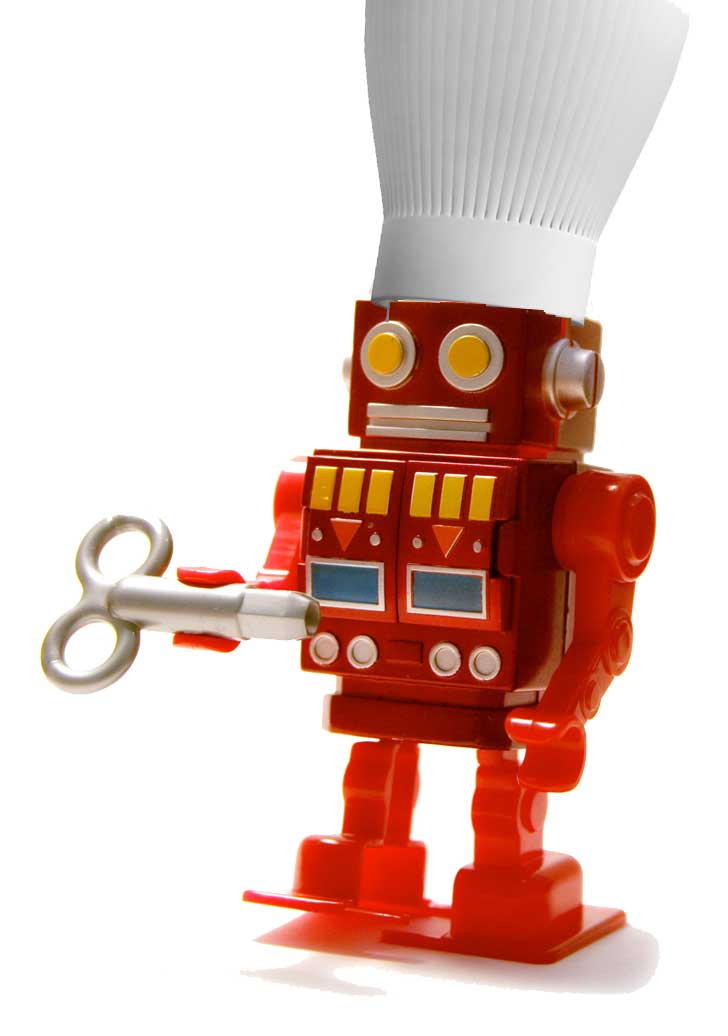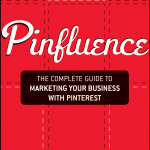Have you met this guy? He’s a very sneaky sort of villain.
He’s what we call around here an Evil Chef Robot. And he’s just one of several marketing-type enemies that could hurt your solo business. Let’s take a look-see, shall we?
How to Spot Them
These buggers tend to catch your eye every time you get that feeling of overwhelm over how much crap important marketing tasks you have on your To Do list.
You hear this tale about how a friend-of-a-friend-of-a-friend automated all their social media. They (allegedly) gained an extra three hours a day and now take power naps while you’re stuck at your desk trying to figure out how you’re going to fit Pinterest into your already over-loaded schedule.
You find out that guy used Hootsuite and before you can say Boston Creme Pie, you’ve got your own account hooked up and ready to go. Guess what? You’re this close to over doing it and letting the Robot Chef take over everything.
Here’s how to avoid going to the dark side:
1. Use the apps and robot tools sparingly.
Hootsuite is great. I use it myself. But what I don’t do is schedule every last tweet, Facebook post or LinkedIn share. If I did that, I’d be defeating the purpose of using social media to market my business. (Which, as you already know, is to build real relationships with humans — not robots.)
My recommendation is to save the auto-posting for those occasions when you know you’ll need a little extra oomph. That extended vacation doesn’t have to mean you go silent. And if you’ve got a product launch and you’re working with sponsors, you may need to ensure that specific tweets go out at predetermined intervals.
The idea is to stay away from automating your sharing as much as you can. Why? If you send out a tweet and somebody replies but you’re not there to “hear” it and answer it, people will wonder if you’re purposely ignoring them or just absent-minded.
No, you’re not expected to respond immediately to everything. But it will seem pretty lame if you’ve auto-posted a question (because those are the best kind to encourage engagement) and people respond to you, and then…crickets. Automate too much and folks will begin to ignore you or, worse — unfollow-unfriend-unlike the heck out of you.
2. Don’t try to be everywhere.
Realistically, you can only drink from a fire hose for so long. Don’t drink from a fire hose.
Choose two or three social media channels (where your ideal customers hangout most) and focus like a laser beam on owning those spaces. Don’t add anything new until (and unless) you feel you’ve mastered what you already have on your plate.
3. Be aware of cultural differences.
Yes, you can connect your Facebook Fan Page to Twitter (so posts are auto-shared), but I don’t recommend you auto-share your Tweets with your Facebook friends. Those are two entirely different spheres with their own cultures and lingo. Twitter lingo doesn’t work on Facebook and folks will get annoyed with your #hashtags, RTs and weird abbreviations. (Don’t auto-share your Tweets on LinkedIn for the same reason.)
4. Third-party automation on Facebook is frowned on.
If you’ve got your blog or email campaigns set to auto-share on Facebook, be aware that the posts probably won’t show up much (if at all) in your fans’ newsfeeds.
Facebook has this thing they call “Edgerank” which prefers that you do your posting as a human. So be sure to follow up those auto-posts with one you do all on your own. This also gives you a chance to share with particular groups that might find your post useful, and to add a pithy comment or ask a question that might start a conversation.
5. Choose quality over quantity.
Ten thousand Facebook fans is possible. But unless your fans grow organically, you may be amassing all the wrong types of people.
Also – Twitter followers that you gain through apps that auto-follow are not the best type to have. Yes, folks have built massively large followings using some of the tools. But do they know these folks? Have they ever exchanged pleasantries with them? Probably not. All they’re doing is creating a whole bunch of noise.
And really — why would you want someone to follow you on Twitter with the only goal to get you follow them back? There are tons of people auto-following and then unfollowing when the favor isn’t returned.
Obviously, there are many other tools for automating your marketing than can be covered in this little post. We automate everything from our emails to our calendars to entire campaigns. Some of this good and healthy. And some of this just makes us lazy.
My point is that your marketing — and specifically your time on social media — should be mainly focused on human-to-human interaction. Not promoting your latest thing.
Marketing-type tweets and shares should be no more than 20% of your overall communication. The rest should be sharing other people’s awesomeness and building relationships. Period. Stay vigilant. If you find yourself leaning more toward automation than conversation, it’s time to stop and assess. (<– There’s a reason “ass” is the root of this word. I’m just sayin.)
It might be happening because you’re not enjoying the process. And if that’s the case, then stop. Everyone can tell your heart’s not in it.
Have you ever met an evil chef robot or other marketing villain? Share your experience with us in a comment below. (And stay tuned for more marketing villain exposés.)











Hi Tea,I think your advice for using the auto bots for when you are gone or in the midst of a big project is some of the best I’ve read. Hadn’t really thought of using them that way before!I have also understood the fact that FB doesn’t like autoposting and I fully agree that feeding one post to all networks make no sense. If you pick one or two as you said and really participate just as you would in normal conversation, I believe it will work much better. For me it’s LinkedIn and other blogs right now. I’ve made some really good connections lately and I can almost guarantee that would not have happened by way of automatic updates etc.
You not only write succinct advice here Tea, you walk the talk. Everything you do has that personal touch. I get torn between taking the time for existing client demands and the pull to be updating social media. 24 hours doesn’t go very far.The existing client has to win otherwise it’s costing more effort trying to get new clients than nurturing the ones I already have.Identifying the very few really important social media sources to uncover my potential clients takes discipline and focus. It’s good to hear it from you.
Tea, this was not only completely relevant and real but laugh-out-loud funny. I’m still amused by the fire hose reference (even the corrected version). I’m a very “don’t jump on the bandwagon” kind of person. You are absolutely right about auto posting, which is what so many people do because who has time to manage 600 social media accounts every day?? Pick the places you want to be and where you have the best community and best success. I remember not so long ago when Pinterest became this total THING that was suddenly responsible for like, 98% of all the traffic ever generated to anyone’s website. Who the heck needs another pin board? I know people who ran out and put up literally thousands of “pins”. But something has to give in the meantime. While you’re out there pinning (or whatevering), there’s something else you’re NOT doing. Maybe paying attention to your Facebook fans. or your LinkedIn groups.Anyway. Resist the machine and all its evil robot chefs.
Tea, I thought I would bust a gut laughing when I read …” … you alone can only drink from a fire hose for so long.” LOL! :)The “I see you everywhere” wish most online marketers (secretly and openly) pray for is the proverbial “double-edged sword”.I’d like to see biz coaches and social media consultants CLARIFY one important factor with their clients about making their goal to be seen everywhere on the net.The clarification? You can’t open 10 or 20 social media accounts (and some folks have a whole lot more than that!) and, realistically, be ACTIVE on all those platforms at once. Ain’t gonna happen till pigs can fly!Your post is telling it like it should be in the cuckoo world of social media marketing. It’s not humanly possible to have genuine, meaningful conversations and interactions from EVERYWHERE at once!Good on you! Love this message.
Totally agree about how tempting it is and how auto stuff doesn’t build real relationships… I haven’t even looked at Pinterest – I don’t have time at the moment to start pining pix of anything anywhere… and I haven’t figured out how doing so would bring me clients who want help writing a book… maybe I’m missing something, but if I am it will become obvious and I can adjust.
YES to all of that, a few thousand times over. I cringe every time a client asks me about Pinterest, for example. Not because I hate Pinterest. (I don’t. I think it’s cool as hell, scary copyright issues notwithstanding.) But because almost always, that client’s targets are NOT gonna respond to the client’s content via Pinterest, so there’s no real reason to be there. While automation and its cousin, business-systems-creation, are both awesome things, they must – MUST – serve the purpose: bringing in more clients + customers.
Great post Tea!Though I don’t know this guy (lols!) but yes, it’s real tough to juggle and manage your time on all the social medias with so many of them cropping up all the time. The latest of course is Pinterest, which sure is addictive and takes much of your time.I also agree about the tools like Hootsuite or Marketmesuite, though I too am not in the favor of sharing the same things on Twitter or Facebook, as both medias cater to different kinds of people. I guess manual interaction is something that works best.Thanks for sharing 🙂